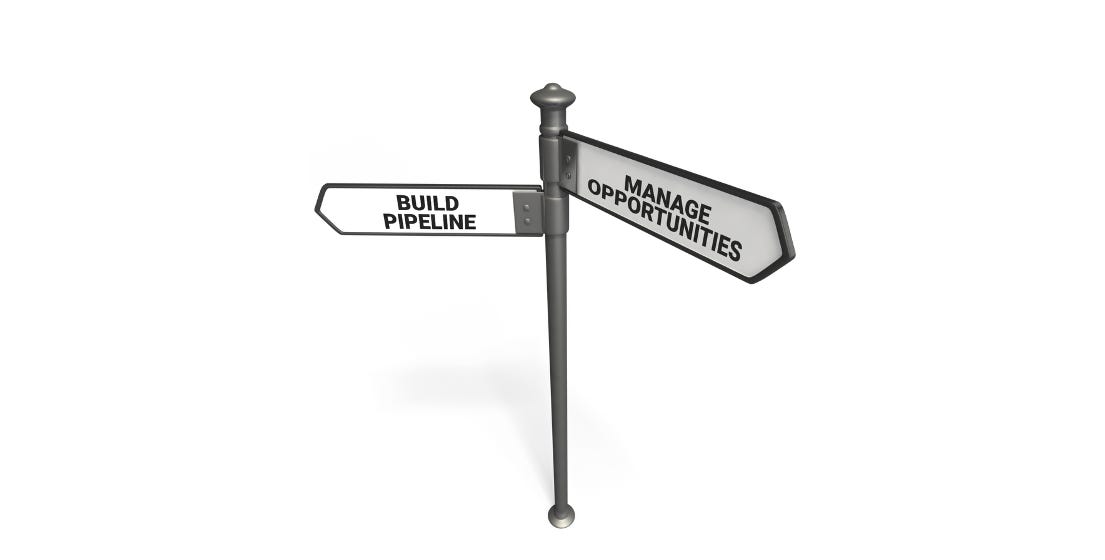For those on annual sales cycles, mid/late Q2 represents a critical turning point.
It's officially time to shift our primary focus from building net new pipeline to developing and managing our qualified opportunities.
Of course...we never stop engaging with prospects about new opportunities. However...as many organizations, both seller and buyer alike, operate on a calendar year for transactions, we must pivot to focus on developing existing opportunities in our pipeline.
Step one is to continue qualifying those opportunities and moving them forward with velocity. Use these questions to determine the fate of an opportunity - up or out!
Is the opportunity real?
Does a compelling event exist?
Has the customer committed appropriate resources to evaluating the proposed approach, to building an evaluation plan, to building an implementation plan?
What is the priority of this initiative relative to others on their plate?
Are there stakeholders not deeply engaged in the conversation?
Does the customer have the bandwidth, staff and expertise to conduct a successful implementation?
Is there an agreed on path and timeline for moving forward? Is this validated and modified regularly?
At some level, do you have a meeting of the minds?
Are you engaged with the "right" stakeholders? Have you met them F2F? Are you texting with them?
Do you have agreement on the potential business impact and the proposed solution?
The next step is to ask this question:
What else must be true for this opportunity to be CLOSED/WON?
By asking this question you will uncover issues, new stakeholders and influences that don't show up in the linear evaluation.
Step three is to work backward from the Go Live date - the "by when" the solution must be up and running, in production, without the old platform, application, system or services running in parallel.
When must the solution be stood up, implemented, validated?
How long will it take to implement?
How long will the contracts/agreements take after a formal "GO" decision is made? Are you managing this work in parallel with technical evaluations?
How long will the proof of concept take (if one is needed)? What resources are needed? Are they committed? Have you helped the customer to draft a good set of evaluation/success criteria?
The sales manager/sales leader perspective
Y'all know that sales people have happy ears...that when a customer says "maybe", the sales person hears "absolutely!"
As manager or leader, you must bring your experience of successful engagement flow to the opportunity review with the rep. Not every rep thinks ahead, covering every nuance of the path required.
Your opportunity is to provide coaching rather than inspection. Coaching is useful, welcomed, appreciated. Coaching provides a foundation for future success.
Inspection, on the other hand, is feared, hated, reviled. It has little to offer the rep, other than an exhausting set of questions that seem only to fuel additional visibility for management. Nothing for them. Nothing to actually help the rep move the opportunity forward.
And...inspection is destined to fail. Reps don't know what they don't know. In fact, you as manager don't know what you don't know.
You don't know that while your rep has been talking to the technical lead twice a week for the past six weeks, they've only talked with two of the business stakeholders once. That the sales engineer hasn't checked in on the POC in a month. That the tone of the conversation with another key stakeholder has changed.
You believe that the influence chart, built in Salesforce or PowerPoint, gives us full visibility into the strength of the many relationships.
Relationships aren't that simple.
They're multi-threaded. They wax and wane. They run into blocks, challenges, disagreements, breakthroughs. Connections form, strengthen, weaken and break all the time!
It's the strength of the relationships that determine the outcome of an opportunity.
If only we had accurate intelligence on the state of our conversations and relationships with customers,
If only we could look at the scope and tone of the conversations in email and on Zoom calls, and then correlate them to SFA records, we'd have a much better view of the strength of an opportunity.
With that comprehensive view of opportunities, both successful and failed, we could build a highly prescriptive model of what good looks like. This could become a coaching tool to help reps focus on the activities and relationships that matter. And it would dramatically improves our confidence in forecasting and managing those opportunities,
Hey Lee, is this possible?
I've been thinking about these sources of conversation, relationship and revenue intelligence for a long time.
It's all there...in Salesforce or Hubspot, in email, in the transcripts of Zoom meetings...
And yes, it's now possible to aggregate, correlate and leverage that information to improve your pipeline quality, to boost your CLOSED/WON rates, to improve both sales team effectiveness and efficiency.
Curious? Lets talk...





No comments:
Post a Comment